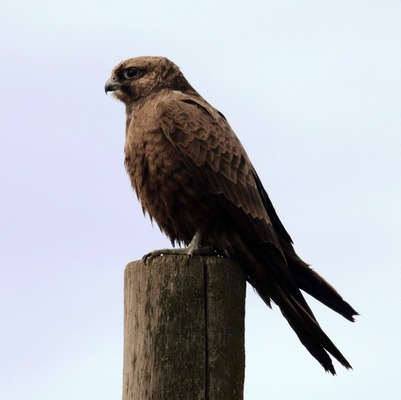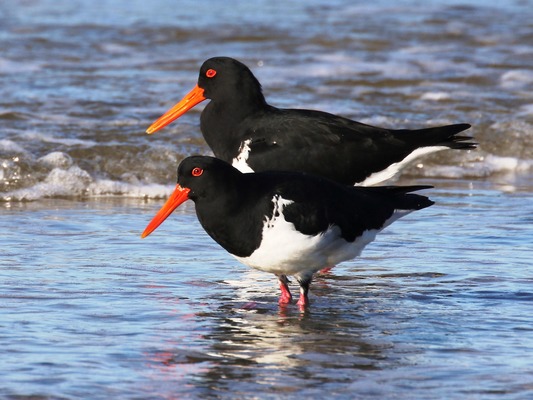I’ve spotted some amazing raptors lately on the Bellarine.
One foggy morning I had a quick drive through Curlewis and I was thrilled to see a black falcon just perched on a post.
I think the black falcon was cold as it didn’t fly off when I stopped to photograph it, but the photos were pretty ordinary due to the conditions and poor light.
In the same paddock I saw five dusky woodswallows, which are nomadic birds that move from the southeastern ares to northern Australia in autumn, so these birds no doubt have moved north since considering how cold it has been.
A few days later I was driving down Grubb Rd towards Drysdale on my way to work and right out in the open was a magnificent grey goshawk (white morph) in a perfect spot for a great photo. Unfortunately Grubb Rd is a busy area and by the time I made a safe U-turn the goshawk had moved into a sheltered area, and my photos were again ordinary.
I have been thinking that I hadn’t seen many flame robins this winter in the usual spots that I see them.
Lo and behold I was driving near Connewarre a few days ago and in a paddock I saw 12 flame robins. In winter flame robins generally move from mountainous regions to lower and more open areas and form a flock, so it was great to spot a decent number of them.
I’ve had a few trips to Western Treatment Plant with Bellarine locals Tom and Jen. The highlights were seeing a pair of wedge-tailed eagles, plus a large number of whistling kites. It’s certainly been a raptor feast for me over the last few weeks.
Speaking of raptors, Ocean Grove local Lynne spotted a little eagle (pale morph) circling over her house as it moved in a southerly direction towards Begola Wetlands.
Lynn also saw a nankeen night-heron high in a tree at Blue Water Lake in late March. Lynne also reported that eastern rosellas are eating her correas again, but she has had no small birds in my garden for ages which is so disappointing.
Kevin went to Portarlington one afternoon and found two pied oystercatchers just beyond Indented Head and one of the birds was wearing a silver leg band.
Carole from the Bellarine Birdlife Group emailed me to report a sighting of a shy albatross, which she was thrilled to see while at Point Lonsdale.
The shy albatross was drifting more towards the Portsea side of the heads rather than Queenscliff, and Carole watched it for about 20 minutes.
Carole also sent me an image of a female Australian shelduck that she saw in a paddock near Waurn Ponds.
The Australian shelduck is a large, brightly coloured duck with a small head and bill. Males have a white neck ring and occasionally a white ring around the base of the bill. The upper parts are mainly black, while the underparts are dark brown with a cinnamon breast.
The female has a white eye-ring and a chestnut breast. Seasonal movements of shelducks are regular.
In summer shelducks gather on large lakes to feed and moult (they cannot fly while moulting) then disperse to breeding areas in autumn and winter.
Some journeys are long; birds from south-east South Australia are found throughout Victoria and Tasmania after the breeding season, and birds from near Canberra have been known to reach Tasmania and the south-eastern tip of South Australia.
I was very excited to read on Facebook that Brooke from Parks Victoria, and Beth from the Friends of the Ocean Grove Nature Reserve (OGNR), found a baby echidna (known as a ‘puggle’) in the nature reserve.
Known as monotremes, echidnas and platypus are the only mammals that lay eggs.
While on the subject of the OGNR, Brooke asked me to mention that dogs are prohibited in the reserve and bikes are not permitted on walking tracks.
Recently a woman was seen walking two large dogs off lead in the reserve, and when there are vulnerable creatures such a puggles in the reserve, this behaviour is just so disappointing. There are clear signs about dogs not being allowed in the OGNR, so please adhere to the signs.









